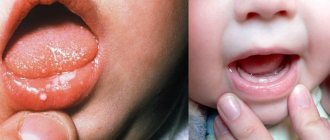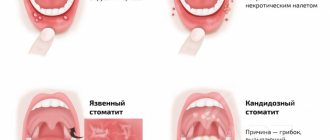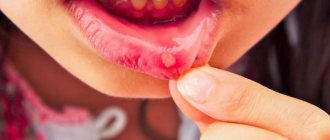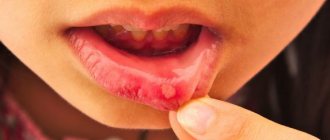Description of ulcerative necrotizing stomatitis
This disease refers to infection with a spindle-shaped rod or spirochete, which is called Vincent. World medical dictionaries describe the disease under terms such as trench mouth, sore throat and stomatitis with the presence of various types of ulcers. If the bacterium affects the gums, then doctors interpret the diagnosis as Vincent gingivitis. In practice, there are situations when the infection affects several parts of the human body. For example, the palatine tonsils may be affected, and then this disease is called Vincent's angina.
Classification of osteomyelitis
In most cases, osteomyelitis of the jaw is a consequence of caries, as well as a complication after periodontal disease.
This group of osteomyelitis is usually called odontogenic (stomatogenous). The infection enters the bone structures through caries-affected molars. In areas of inflammation there is a variety of microflora. These include streptococcus, staphylococcus (white and golden), pneumococcus and other bacteria.
Contact osteomyelitis is a pathology that occurs due to infection of the skin or mucous membrane (for example, with a facial boil). Here are specific osteomyelitis:
- tuberculosis,
- syphilitic,
- actinomycotic.
Sometimes damage to the bone marrow of the jaw occurs due to bacteria entering the bloodstream. This condition is classified as hematogenous osteomyelitis, which occurs after infections such as influenza, typhoid fever, scarlet fever, and measles.
A separate group consists of osteomyelitis resulting from trauma (fracture, severe bruise). Vincent's symptom in fractures, when sensitivity in the area of the mental nerve is impaired and patients note numbness of the lower lip, occurs due to compression of the lower alveolar nerve, formed due to inflammation with exudate.
Causes of infection
The main cause of the disease is resident flora. It is this that causes Vincent’s stomatitis in most people. Microorganisms are found in the oral cavity of every person, but there is a maximum permissible limit. Exceeding the optimal number of bacteria is observed when the rules of caring for teeth and gums are violated. Unsanitary conditions contribute to the proliferation of infectious microbes, which cause necrotizing ulcerative stomatitis. We have looked at the most common cause of painful symptoms, however, there are also the following pathogens:
- Borrelia or Fusobacterium infection
— these microorganisms appear when a person’s immunity and ability to resist infections decrease. You can get stomatitis if you are frozen, have a cold, or are regularly overworked and in stressful situations. As you can see, this type of bacteria can multiply for many reasons;
- damage to the oral cavity, trauma, improper hygiene care
— if the integrity of the mucous membrane is compromised, then optimal microflora conditions are created for bacterial invasion. Very often observed in patients who have experienced periodontitis. The second reason for the manifestation of Vincent symptoms can be careless oral hygiene. So, if there are wounds or cracks, they become clogged, which leads to the development of infectious bacteria;
- complications of viral infection
— if stomatitis is not treated in time, treatment in adults or children may result in serious health complications. As a final result, the disease will move to a new level of danger, for example, leukemia, scorbuta, syphilide and others will form.
Vincent's symptom in dentistry. Periodontitis
Periodontitis is a pathology caused by infection from the carious cavity into the bone tissue through the apex of the root. The disease causes inflammation of the tooth root membrane. If left untreated, periodontitis manifests itself with various signs, including Vincent's symptom. The reversibility of the disease depends on many factors: the timeliness of seeking medical help, the general condition of the human body, etc. Let us consider the mechanism of occurrence of the pathology.
Deep caries leads to pulpitis - inflammation of the pulp, as a result of which microorganisms enter the periodontium through the root canal.
There are also other ways for bacteria to penetrate bone tissue, for example due to trauma or sepsis, but pulpitis is the most common cause of inflammatory processes in the bone. During inflammation, fluid leaks out, and the periodontium, a tissue saturated with receptors, reacts to an increase in pressure. In this case, inflammation causes pain.
A characteristic feature of periodontitis is increasing throbbing pain, which is strictly localized. Sometimes, when closing the teeth, the pain is difficult to endure, and patients cannot eat. It hurts a person just to touch the edge of a tooth, which also becomes mobile, the gums around the tooth, as well as the lip and cheek, swell, and the body temperature rises sharply. A concomitant sign of periodontitis may be Vincent's symptom. Its signs have already been noted earlier: numbness and loss of sensitivity of the tissues in the chin area.
Types of stomatitis for treatment
There are four levels of classification of the disease, each of which has its own subtypes. To determine treatment methods, you must know the correct diagnosis. Therefore, it is necessary to consider the types of Vincent’s infectious disease:
- In the division regarding the nature of the course of the disease, acute, subacute, chronic ulcerative-necrotic degrees and relapse are distinguished.
- Regarding the complexity of the disease, stomatitis is mild, moderate and severe.
Each type manifests itself in different symptoms, so in the next section we will look at what the patient feels at each stage of the disease.
Forms of periodontitis
There are acute and chronic forms of periodontitis. If, during inflammation, the resulting fluid leaves through the root canal of the tooth, periodontitis becomes chronic. The pain syndrome is not very pronounced, and the pathological processes in the apex of the tooth proceed slowly. Bacteria, multiplying in the area of the affected bone, release toxins that “poison” the human body and lead to the development of diseases of various organs and systems (joints, heart, kidneys).
Otherwise, an acute form of periodontitis develops, which over time, in the absence of proper treatment, can develop into a purulent stage.
The above forms of periodontitis require long and highly qualified treatment. The main goal of therapy is to ensure the outflow of pus from the site of inflammation. During the treatment process, the inflammatory process is first stopped, then antiseptic treatment of the pulp is carried out, then a temporary filling is installed. During the period of therapeutic measures, the condition of bone tissue is monitored using radiography.
The main symptoms of stomatitis in adults
The main symptoms should be considered at different stages of the disease. It is worth noting that the disease progresses and becomes more pronounced over time. When affected by an infection, a person begins to feel weak, he regularly has headaches, there is an increase in temperature and brittleness in the joints. The patient may notice blood on the gums, feel burning and drying of the oral mucosa. Such symptoms torment a person for several hours, and sometimes for several days.
When examined by a doctor, the stage of stomatitis, symptoms and treatment are described. In this case, the optimal course for the stage of the disease is selected. The disease progresses and gradually all its manifestations intensify. The person’s general condition becomes weaker, headaches become more frequent and severe, which affects performance. Over time, the patient feels a sharp pain even with slight contact with the tongue. Brush your teeth
and it becomes more and more difficult to eat, as sharp convulsive bursts of pain occur. At the same time, the patient notices increased secretion of saliva, and also an unpleasant smell of rot from the oral cavity. If a wisdom tooth becomes infected, the ability to open the mouth decreases. This phenomenon in medicine is called trismus.
Some facts about the symptoms of the disease at different stages:
- the first manifestations of the disease are pain in areas of damaged teeth and damaged gums;
- Mild stomatitis is characterized by a limited spread process. At an early stage, only certain types of teeth are affected. The general condition of a person does not undergo significant changes, so performance does not suffer either;
- Severe stomatitis occurs with a body temperature of up to 40 degrees. At the same time, the person feels very bad. The mucous membrane of the oral cavity is especially severely affected. In some situations, the infection affects muscle mass and bones. If you do not seek help from a hospital in time, complications of the disease can lead to melting of the jaw bones. You can easily see the image of stomatitis in the photo, the treatment that was started;
- if the infection gets to the site of the palate or tonsil, then this disease belongs to the category of angina ailments;
- in the acute form of stomatitis, the disease can progress to the chronic stage.
- Males are most often susceptible to infection at a young age, namely from 17 to 30 years. The season of exacerbation of the disease is observed in the autumn.
Vincent's angina. Symptoms and treatment
Ulcerative membranous tonsillitis manifests itself with a whole complex of characteristic symptoms. These include:
- Enlargement of the affected tonsil. The disease predominantly affects one of the parties.
- Enlargement and moderate tenderness of regional lymph nodes.
- The formation of a grayish-yellow coating on the mucous membrane of the palatine tonsils, which can cause the formation of superficial, slightly painful ulcers with a gray bottom. If the pathology progresses, ulcers appear in other parts of the pharynx, as well as on the mucous membrane of the cheeks or gums. Sometimes ulcers can heal without forming any defects.
- When eating food (when swallowing), painful sensations occur; patients note increased salivation and bad breath.
- Body temperature during pathology in rare cases exceeds normal limits, although sometimes the disease can begin with a high temperature and a state of chills.
- Numbness and loss of sensation in the chin area.
Treatment of the pathology is aimed at eliminating inflammation of the mucous membrane of the throat. Often, otolaryngologists prescribe products to rinse or lubricate the affected area. In case of a protracted course of the disease, antibiotic therapy is used. Patients with ulcerative membranous tonsillitis are always isolated; in severe forms of the pathology, they are hospitalized. The main principle of disease prevention is to strengthen the body's protective functions and increase immunity.
Diagnosis of stomatitis in children for treatment
As we said earlier, young men and young children under 3 years of age are most often affected by the disease. Diagnosing the disease is only possible in a clinical setting. When analyzing, they try to find symbiotic organisms. If their presence is detected, then a course of treatment is prescribed. It is especially important to timely diagnose the presence of infection in young children, since their bodies are still weak to resist infection.
If stomatitis turns into a sore throat, then it is necessary to take an analysis of a sample from the surface of the necrosis or a deeper layer, in case of a complicated form. It is worth noting that Vincent’s illness very often accompanies other dangerous diseases, including HIV, leukemia, syphilis, gingivitis, scorbuta and others. It is for this reason that the examination often includes procedures to screen out the above diseases. When stomatitis is detected in children, treatment is prescribed only after an accurate diagnosis.
Treatment methods for stomatitis
In order to successfully get rid of the disease, it is best to perform sanitation of the oral cavity. After eliminating the pain, doctors can begin to remove ulcers and unwanted deposits. In practice, a course of antibiotics is most often prescribed. So, an adult should drink about 4-5 tablets a day; for a child this norm is reduced to one. Also effective methods of treating the disease include:
- antiseptic substances
- it is recommended to rinse your mouth with them at least 4 times a day; - trichopolum
- for optimal treatment, it is enough to take half a gram per day; - antihistamine therapy
- this method helps to suppress microbial sensitization; - in the vitamin complex
- to maintain the tone of the body, as well as strengthen it, it is recommended to consume vitamin C at least one and a half grams per day; - keratoplastic ointment
- it is used to lyse infectious plaque.










